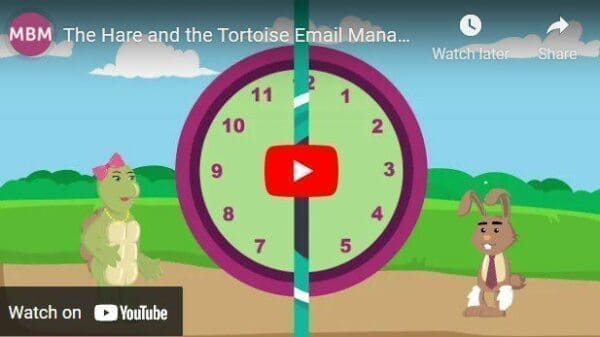Emails. Create a chain around our neck to our inbox that only seems to get harder to break. Where will it all end? Learn how to manage the email overload.
The biggest challenge at work is fast becoming that chain. We feel chained to our emails. According to Blue Hornet, over a third of people check their email throughout the day – stuck in their inbox. If this is you, you are not alone and you are killing your productivity.
Let’s look at why we are chained, why we kill our productivity performance and how Hares & Tortoises can help to manage the email overload.
So, What do the Psychologists Say on Email Overload?
‘Lottery brain’, writes Nancy Colie in ‘Psychology Today’. Nancy shares with us that the reason we check our email constantly is that it is an addiction. Addictions don’t make rational sense. They are born from repetitive behaviour. The deep psychological reason behind why we check our email is akin to why we gamble. The hope of something exciting.
In the case of email – a job offer, an email from a friend, a sales win, or gratitude. And even though these are rare, we continue to repeat the behaviour. Like pulling the arm of an old gambling machine. ‘We know that we’re unlikely to win, but what if we did?!’ – That’s what goes through our irrational animal-like brain.
My own experience of the lottery brain is that it is very real. In my corporate job, I came into the office, grabbed a tea, some cereal in a bowl, and sat at my desk in my inbox. I was trying to ‘clear my emails’ before my first meeting, though, looking back, that never really happened. My inbox just seems to grow. I’d answer the easy ones. This is what the time management experts call ‘QFE’. Starting with the Quick, Fun, and Easy.
I never even knew what deep work was. I was just fighting all day long to stay ahead of the game. Trying, and often failing, to ‘stay on top of my emails’. Hoping for a long run (a day without meetings), where I could get to less than 50 emails in my inbox. That felt good, but was as common as Haley’s Comet!

Nancy Further Explains That the First Step to Change is Awareness
By simply noticing the impulse to check, and checking in with ourselves to ask ‘Why?’, is the beginning. She writes, ‘Getting to know the beast is the first step in taming the beast’.
Sticky Learning ® is 7 times more effective than 1-day training courses. Plus, you will get a Chain of Evidence proving your Return on Investment. Discover soft skills training that changes behaviours long term.

Productivity Affected by Checking Our Email?
A resounding YES. ‘Based on over a half-century of cognitive science and more recent studies on multitasking, we know that multitaskers do less and miss information. It takes time (an average of 15 minutes) to re-orient to a primary task after a distraction such as an email. Efficiency can drop by as much as 40%.’, writes Paul Atchley in the Harvard Business Review.
Every time that pesky email notification pops up to say you have a new email, you start multi-tasking. One of the biggest myths is multi-tasking. If you believe in multi-tasking, then Loch Ness is worth seeing for its monster is fabulous. Multi-tasking is the ability to do two things well. The research tells us that unless the tasks require very little intelligence, like unloading the dishwasher whilst speaking to your spouse, then you risk doing two tasks with only the intelligence of a 12-year-old. And yes, even women. Whilst they can multitask better than men, neither gender can multi-task effectively on two tasks that require the super-intelligent brain you were hired to use at work.
Each Knowledge Worker Receives 88 Emails Per Day
This is the main cause of multi-tasking. Emails. We all do it – focusing on a task, trying to get it done well because it is important, but also trying to keep one eye on your inbox. Not helped by those ever so annoying, must look at, notifications. So, the average is 88 emails per day. That’s something waving to distract you every five and a half minutes. So, if Paul is right, that it then takes 15 minutes re-orient, when do we get our deep work done?
‘There is a cost to task switching’, says Cal Newport, an Assistant Professor of Computer Science at Georgetown University, and the author most recently of ‘Deep Work: Rules for Focused Success in a Distracted World’. The challenge is that in today’s world there are so many distractions that we struggle to do the meaningful work (deep work). The work that Pareto’s rule would suggest makes 80% of the difference to our performance. And instead, we are ‘busy’ working on the 80% that only makes 20% of the difference to our performance.
Email is the biggest distraction in the workplace. There has never been a productivity tool that has been more used and yet used badly, than email. Imagine a carpenter with a blunt saw. This is Outlook, Gmail, and every other email system. Yet, a bad workman blames his tools. Using the tools better is the key. Stopping to sharpen the saw, as Stephen Covey, advised us in Habit #7 of ‘The Seven Habits of Highly Effective People’, is the key.
Let’s Sharpen the Saw…

Imagine a clock face in two parts. I’m going to refer to the fable of ‘The Hare and the Tortoise’. If you don’t know it, a quick recap. The hare and the tortoise challenge each other to a race. As they ‘race’ the hare gets so far ahead that he takes a nap. Meanwhile, the tortoise takes it ‘slow and steady’. Eventually overtaking the napping hare, winning the race and managing the email overload.
From 12 to 12.20 is the Hare time. From 12.21 to 12.59 is the tortoise time. Bring the clock to life by imagining the hare running in that 20-minute segment and imagine the tortoise walking steadily in the 40-minute segment.

This is a new way of looking at your emails. The challenge is to do so because it will enable you to do the deep work. Be less distracted, and yet still manage your emails. Using the hare and the tortoise system will help you to achieve this.
Using the hare and the tortoise email management system is simple. If the time is between the hour and 20 past, look at your inbox. Work fast, aiming to clear as many emails as possible in 20 minutes. Know that you only have 20 minutes and can only do emails for that long. If the time is between 21 minutes past and 1 minute to the hour, do the deep work; Projects, Strategic Thinking, Mind Mapping, Solving Problems – In essence the big stuff that you keep putting off.
I Know What You’re Thinking…
‘Ah, but you don’t know my clients and our business’. You’re right. I don’t. I do know that you want to be more productive because you want to deliver more and be more satisfied at work. The illusion of productivity will not achieve that because you cannot do the deep work. The work that makes the real difference if you are distracted every 5 minutes. So, what’s the answer?
Identify the two or three people that believe that when they email you they should get a response within 15 minutes, and arrange something different. For example, in your next meeting, explain that you want to be more productive for them. Therefore, if it is urgent, text me.
If you’re now thinking, ‘You still don’t know my clients or our business’. You’re still right. If you truly need to be in your inbox then 3 things need to happen:
- Cancel lunch, unless you have it at your desk every day.
- Abolish any meeting over 15 minutes.
- Cancel all holidays.
Unless you made arrangements to cover those 3? Of course, you did.
First Step on Managing the Email Overload
Draw a clock on a post-it note with two segments on the clock face. Write ‘H’ in the 12 to 12.20 segment and ‘T’ in the 12.21 to 12.59 segment. Put the post-it note where you can see it throughout the day. Be the Hare or the Tortoise!





